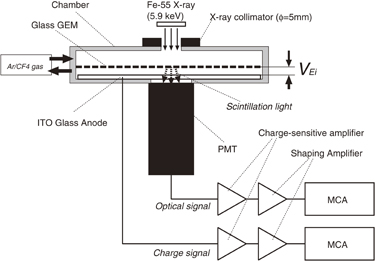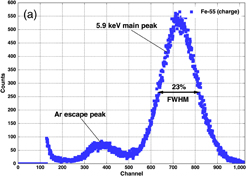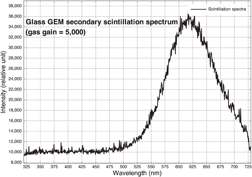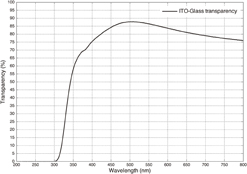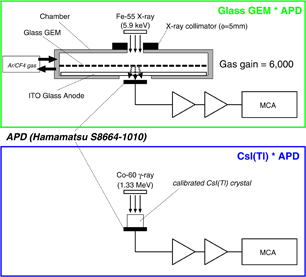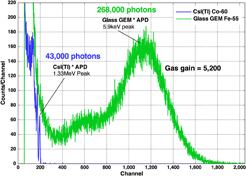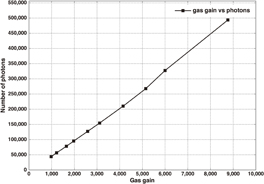Abstract
The glass made gas electron multiplier (GEM) and Ar/CF4-gas-based gaseous detector is developed as a scintillation detector and ultra high photon yield is demonstrated. The light yield of a glass GEM (G-GEM)-based gaseous detector is estimated to be 85,000 photons/keV, which is three orders of magnitude brighter than inorganic scintillators. The radioluminescence spectrum peak appeared at around 620 nm, which matches the spectral response of commonly used photosensors such as photomultiplier tubes, photodiodes, CMOSs, CCDs, and other photo-sensors. In X-ray spectroscopy, the light yield showed excellent proportionality and the device was successfully operated as a gas proportional scintillation counter. With this design, we obtained a high photon yield of the G-GEM, which has the further advantage of being much more sensitive to low-energy radiation than solid-scintillator-based detectors.
Export citation and abstract BibTeX RIS

Content from this work may be used under the terms of the Creative Commons Attribution 4.0 license. Any further distribution of this work must maintain attribution to the author(s) and the title of the work, journal citation and DOI.
1. Introduction
Scintillators are commonly used for various radiation detection applications. They are developed from luminescent materials, which, when struck by incoming ionizing radiation, absorb energy, become excited, and emit hundreds of visible photons. Scintillating photons are detected with photosensors such as a photomultiplier tube (PMT), photodiode, or silicon photomultiplier. Scintillators have played an important role in many scientific and industrial fields, such as homeland security radiation detectors,1) neutron detection,2) high energy particle physics experiments,3) new energy resource exploration,4) X-ray security,5) and computed tomography.6) Up to now, many scintillators have been investigated, most of a solid bulk crystalline form or liquid since most scintillation detectors should be of large volume and high density to detect ionizing radiation efficiently.
On the other hand, various kinds of gaseous detectors have been developed for radiation detection and measurement. In particular, gas electron multipliers (GEMs) are one of the most widely used micro patterned gaseous detectors.7–9) In gaseous detector physics, photons generated in a gas by excitation during the electron avalanche process are referred to as secondary scintillation.10) Scintillation light yield during the gas electron multiplication process in gas counters has long been known.11) Recently, detectors with optical readout utilizing secondary scintillation have been developed as gas proportional scintillation counters,12) avalanche chambers13) to visualize particle tracks, photoluminescence imaging devices14,15) and medical equipment.16)
Meanwhile, we have developed a new type of GEM using photoetchable glass, called glass GEM (G-GEM).17–19) The G-GEM has advantages such as high gain, high discharge resistance, stiff substrate, and low outgassing compared with conventional GEMs. In this study, we have developed a high photon yield scintillation detector with G-GEM, using Ar/CF4 as the scintillation gas. The detector is developed in combination with a gas filled chamber and a transparent electrode as an optical window. To investigate the performance of the scintillating G-GEM detector, we carried out X-ray spectroscopy, measurements of the gas gain, scintillation properties, and quantitative light yield. In this paper, we describe the design and performance of the scintillation detector we developed.
2. Scintillation performance of G-GEM
2.1. Detector design and X-ray spectroscopy
Figure 1 shows the schematic of the scintillation detector using a gas filled G-GEM chamber. The chamber is filled with Ar/CF4 ( ). The G-GEM consists of a glass substrate that has a two-dimensional array of fine holes. There are 128,269 holes in the substrate, and each hole acts as a gas scintillation proportional counter. The G-GEM is fabricated by a photo-etchable glass process,16,18) and the G-GEM used in this work has an effective area of 100 × 100 mm2; each hole diameter is 180 µm, the pitch of the holes is 280 µm, and the thickness of the substrate is 680 µm. More details of the G-GEM manufacturing process can be found in Ref. 16.
). The G-GEM consists of a glass substrate that has a two-dimensional array of fine holes. There are 128,269 holes in the substrate, and each hole acts as a gas scintillation proportional counter. The G-GEM is fabricated by a photo-etchable glass process,16,18) and the G-GEM used in this work has an effective area of 100 × 100 mm2; each hole diameter is 180 µm, the pitch of the holes is 280 µm, and the thickness of the substrate is 680 µm. More details of the G-GEM manufacturing process can be found in Ref. 16.
Fig. 1. Diagrammatic sketch of the experimental setup for measuring the basic performance of the scintillating G-GEM detector coupled with the photomultiplier tube (Hamamatsu R329). The 55Fe X-ray (5.9 keV) source was used in this study, and the X-ray was collimated to ϕ = 5 mm at the entrance window of the chamber. Both the charge and the optical signal were recorded with MCAs.
Download figure:
Standard image High-resolution imageTo collect charges from the G-GEM and evaluate scintillation properties at the same time, an optically transparent electrode is required to be placed as the anode at the bottom of the G-GEM. In the chamber, an anode electrode is placed behind the G-GEM, which is made with a transparent electrode (indium tin oxide: ITO) and a glass plate. The glass plate anode also acts as an optically transparent window of the chamber for the optical readout.
We have tested our scintillating G-GEM detector with an 55Fe X-ray source to measure its basic performance using 1-bar Ar/CF4 ( ) in gas flow. The diagrammatic sketch of the detector setup is shown in Fig. 1. The spacing between the window and the top of the G-GEM (the drift region) was 10.0 mm, and that between the bottom of the G-GEM and the anode electrode was 2.0 mm (the induction region). The electric fields in the drift region and induction region were Ed = 1.5 kV/cm and Ei = 5 kV/cm, respectively. The pulse height spectra of the 55Fe X-ray source obtained from both the charge signal and the optical signal are shown in Figs. 2(a) and 2(b). The spectrum obtained from the optical signal is consistent with the spectrum obtained with the charge signal.
) in gas flow. The diagrammatic sketch of the detector setup is shown in Fig. 1. The spacing between the window and the top of the G-GEM (the drift region) was 10.0 mm, and that between the bottom of the G-GEM and the anode electrode was 2.0 mm (the induction region). The electric fields in the drift region and induction region were Ed = 1.5 kV/cm and Ei = 5 kV/cm, respectively. The pulse height spectra of the 55Fe X-ray source obtained from both the charge signal and the optical signal are shown in Figs. 2(a) and 2(b). The spectrum obtained from the optical signal is consistent with the spectrum obtained with the charge signal.
Download figure:
Standard image High-resolution imageFig. 2. (a) Measured pulse height spectrum with 55Fe X-ray source (5.9 keV). The energy spectrum of the charge readout is shown. Energy resolution is 23% in FWHM. (b) Energy spectrum taken at the same time using a photomultiplier tube. The energy resolution is 25%. The gas gain of the G-GEM was approximately 6,000 at this measurement.
Download figure:
Standard image High-resolution image2.2. Photoemission spectrum
The optical emission spectrum of the scintillating G-GEM and the optical transparency of the ITO electrode were measured. The optical spectrum was measured by irradiating X-rays to the gas filled G-GEM chamber using an X-ray tube (Amptek Mini-X), and scintillation photons were detected with a Czerney-Tuner spectrograph (Andor Technology Shamrock RS303i, 150 lines/mm) equipped with an ICCD camera (Andor Technology iStar). The gas gain of the G-GEM was set at 5,000, and the X-rays were irradiated to the detector with the X-ray tube operated at 10 kV and 50 µA. The resulting scintillating emission was focused into a slit of the spectrograph through two plano convex fused silica lenses (3 cm diameter and f = 40 mm) and detected by the ICCD camera. The spectrum obtained in this experiment is shown in Fig. 3. Unlike Morozov et al.,20) we could not observe any optical emission from the UV regions. On the other hand, the spectrum of visible light matched those in a preceding study carried out by Fraga et al.21) After further investigation, we found that the difference in the optical emission spectrum was due to the low transmittance of ITO glass, which was used as the anode/optical window of the chamber, in the UV region (shown in Fig. 4). The absorption edge of ITO is around 320 nm so that the UV photons from the scintillating gas are fully absorbed.
Fig. 3. Light emission spectrum obtained with scintillating G-GEM [Ar/CF4 ( )]. The peak of the emission wavelength appeared at around 620 nm, which matches the spectral response of commonly used photosensors such as photomultiplier tubes, photodiodes, CMOSs, CCDs, and other photosensors.
)]. The peak of the emission wavelength appeared at around 620 nm, which matches the spectral response of commonly used photosensors such as photomultiplier tubes, photodiodes, CMOSs, CCDs, and other photosensors.
Download figure:
Standard image High-resolution imageFig. 4. Transmittance of ITO glass used in the detector measured with a UV/vis spectrometer (Shimadzu UV-3100).
Download figure:
Standard image High-resolution image2.3. Scintillation properties of G-GEM
In order to estimate the number of photons produced in the scintillating G-GEM detector, we have performed a comparison with a conventional CsI(Tl) crystal bought from Saint Gobain. Since the scintillation emission wavelength of CsI(Tl) (∼550 nm) is close to that of the G-GEM scintillation [Fig. 3 (∼620 nm)], they can be easily compared. In order to consider the flat response of quantum efficiency, an avalanche photo-diode (APD) was used as a photon detector for scintillation spectroscopy (∼80% at wavelengths longer than 500 nm).
First, a 5 mm cubic CsI(Tl) crystal was calibrated for the reference number of scintillation photons.22) Next, the number of photons emitted from the scintillating G-GEM was estimated by comparison with the calibrated CsI(Tl) crystal. A schematic of the measurement setup is shown in Fig. 5. The gas gain of the scintillating G-GEM was set to 5,200, and APD was attached directly to the optical window of the chamber. Through a comparison of the peak channel at the energy spectrum (Fig. 6) between the scintillating G-GEM (under 5.9 keV X-ray irradiation) and the CsI(Tl) crystal (under 1.33 MeV gamma-ray irradiation), the number of scintillation photons emitted from the scintillating G-GEM was estimated as 268,000 (at gas gain = 5,200). The gas gain of the G-GEM as a function of the number of scintillation photons is shown in Fig. 7. The light yield from the G-GEM reached up to approximately 500,000 photons at a gas gain of 8,800, with a single 5.9 keV X-ray photon. The scintillation photon conversion efficiency of the G-GEM can be estimated as 85,000 photons/keV at maximum, which is three orders of magnitude brighter than inorganic scintillators.23,24) However, since the energy resolution of the scintillating G-GEM is mainly due to fluctuations during the electron avalanche process, the detector's energy resolution did not improve with high-yield photon emission and remained as 23 to 26% (FWHM) with a 5.9 keV X-ray. Meanwhile, since the optical window used in this detector is not 100% transparent (approximately 80 to 90%) and UV photons are fully absorbed, there is still room for improving the number of scintillation photons.
Fig. 5. Experimental setup for calibrating photons emitted at the G-GEM. The gas gain of G-GEM was set to 5,200, and coupled to the APD. The calibrated CsI(Tl) crystal was attached to the same setup (the same APD, applied voltage, amplifiers, and MCA) for reference.
Download figure:
Standard image High-resolution imageFig. 6. Pulse height spectrum measured in the experimental setup described in Fig. 5. From the comparison of the 1.33 MeV peak of CsI(Tl) and the 5.9 keV peak of the scintillating G-GEM, the number of photons emitted from the scintillating G-GEM is estimated to be 268,000 (at gas gain = 5,200).
Download figure:
Standard image High-resolution imageFig. 7. Gas gain of the G-GEM as a function of the number of photons detected with APD. The results show an excellent proportionality between gas gain and emitted photons.
Download figure:
Standard image High-resolution image3. Summary
A 100 × 100 mm2 scintillating G-GEM detector was developed and ultra-high photon yield was demonstrated. The light yield of the G-GEM-based gaseous detector reached up to 85,000 photons/keV (while retaining its proportionality), which is three orders of magnitude brighter than inorganic scintillators. The scintillation properties of the scintillating G-GEM were quantitatively studied, and with the use of the photon emission from the Ar/CF4 gas mixture, the scintillation light from the G-GEM matches the spectral response of commonly used photosensors. Likewise, these gaseous based scintillators are suitable for coupling with integration-type photosensors, such as the CMOS or CCD. The high photon yield of the scintillating G-GEM has the further advantage of sensitivity to low-energy radiation compared with solid-scintillator-based detectors.
In addition, G-GEM has the attractive characteristic of a very low outgassing and easy fabrication in large volume. Therefore, it can be said that our detector has the potential to be operated in a sealed chamber and could be an alternative to solid scintillators. Additionally, the large effective area of the gaseous-based scintillation detector would also be an advantage over semiconductor detectors.
Acknowledgments
This work was supported by (i) JSPS KAKENHI Grant Number 15K18316 and (ii) Adaptable and Seamless Technology Transfer Program through Target-driven R&D (A-STEP) Japan Science and Technology Agency (JST). In addition, we would like to thank Dr. Hiromi Ikeura (AIST) for her practical advice.



